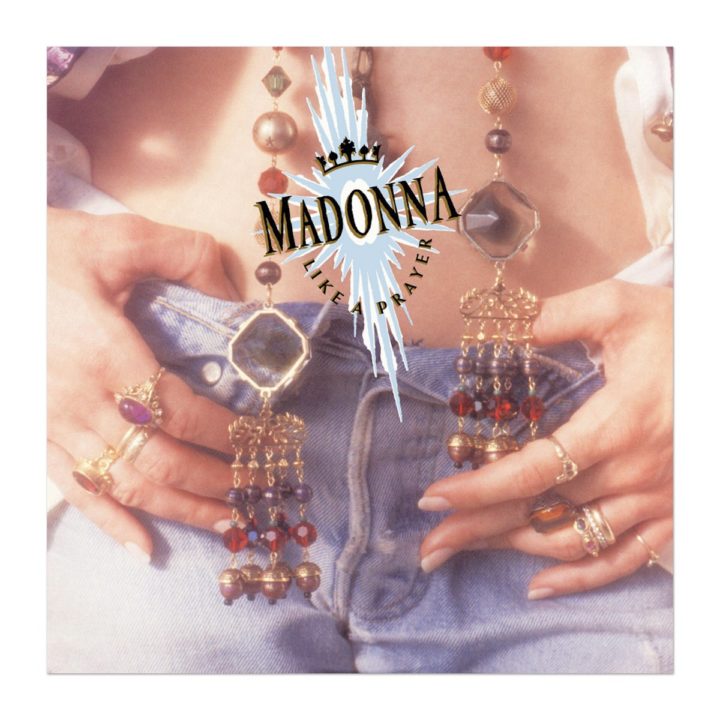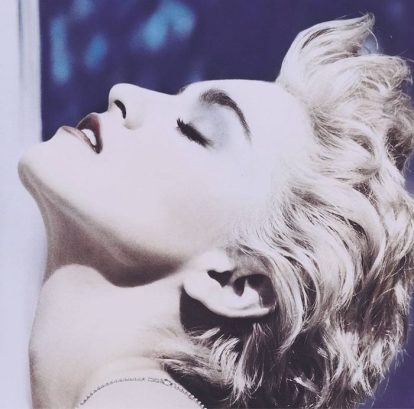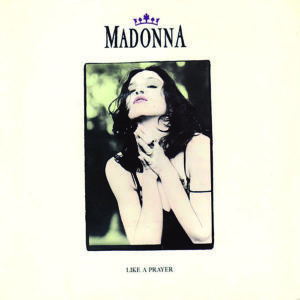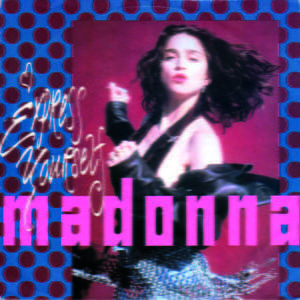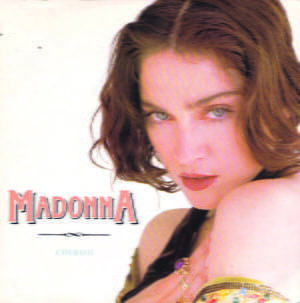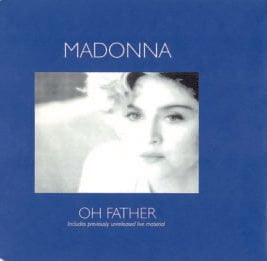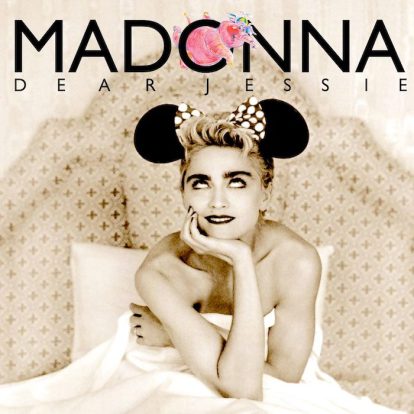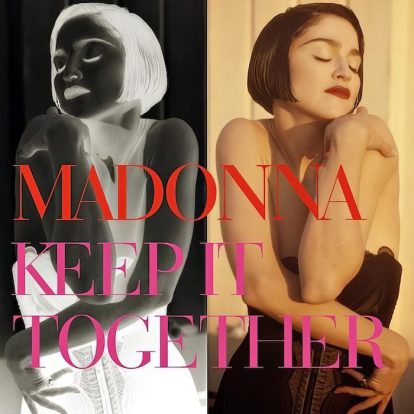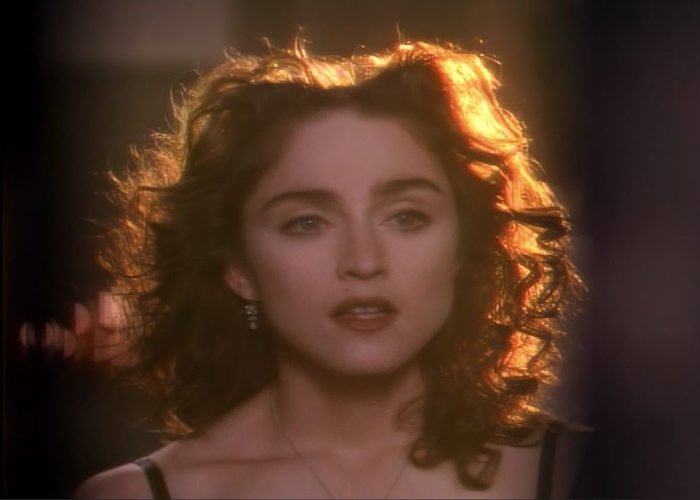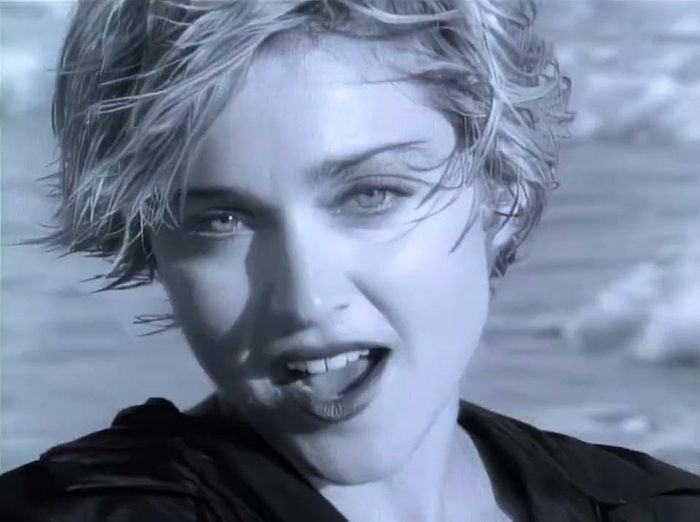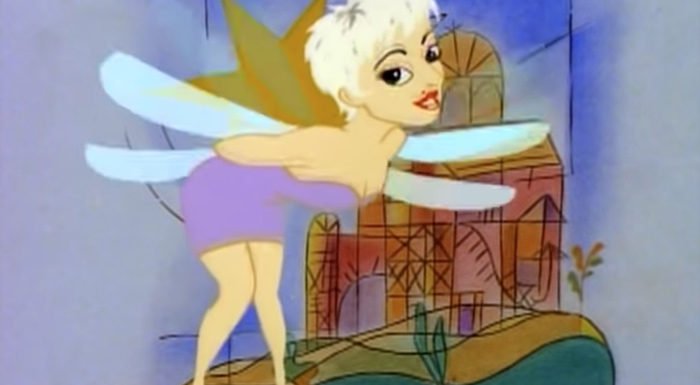Madonna’s Like A Prayer is an immaculate collection of songs which saw the superstar looking inwards for divine inspiration, taking in grief, loss, redemption and empowerment. With the celestial like a prayer, she created her own new testament.
Though Madonna had already established herself as the definitive female pop artist of the 80s with a catalogue of classic hits under her Boy Toy belt, she had found herself at a crossroads in her public and professional life when she entered the studio in 1988 to work on her fourth album. Devastated by the breakdown of her marriage to actor Sean Penn and having recently turned 30, Madonna was feeling increasingly introspective, compelled to confront her feelings about the life-altering events that she had brushed aside for years.
Two years on from True Blue, her most successful album to date, and feeling immense pressure to follow it up, she was desperate to shift focus back to her work from the tabloid caricature that she was becoming thanks to her tumultuous union with Penn.
Tabloid Notoriety
Sean’s propensity to lash out at paparazzi photographers had made him public enemy number one in the tabloids and even landed him in jail. Madonna’s willingness to stand by her man made her guilty by association and earned the couple the moniker, ‘the Poison Penns’.
Meanwhile, her ‘scandalous’ antics with openly bisexual comedienne Sandra Bernhard – dressing in matching outfits for an appearance on David Letterman’s talk show which implied their relationship was more than platonic, and teaming up with Dirty Dancing’s Jennifer Grey and dubbing themselves ‘the Snatch Batch’ (a take on Sinatra’s Rat Pack) to frequent New York’s infamous lesbian nightclub, Cubbyhole, only fanned the flames of her tabloid notoriety.
Pop Supremacy
As the press plotted her inevitable downfall and primed the likes of Tiffany, Debbie Gibson and Taylor Dayne for pop supremacy, Madonna began work on her next album. Having spent her hiatus from the spotlight collaborating with playwright David Mamet on her Broadway debut Speed-The-Plow, and working with filmmakers Woody Allen and Howard Brookner, she was inspired to make the record much more personal than her previous work, delving deep into her psyche and purging her feelings on subjects such as the breakdown of her marriage, the death of her mother as well as her strict Catholic upbringing.
”We called it the divorce album,” says Pat Leonard, who co-wrote and co-produced the LP with Madonna. “Everything took four or times longer to do as she kept breaking down in the studio. It was a hard time for her.”
Promise To Try
While Madonna felt she had proved herself musically by co-writing and co-producing her True Blue album, she felt she had to prove it hadn’t been a fluke and worked again with Pat, feeling they had developed a genuine rapport. Typically, he worked on musical ideas while Madonna contributed melodies and drew from years of her personal diaries and journals to form the lyrics.
The first song they wrote was Like A Prayer, followed by Promise To Try (which dealt with the death of her mother) and Oh Father (Madonna’s account of her troubled relationship with her father and authority figures in her life).
Holy Trinity
Known as the ‘Holy Trinity’ of the album, they became Like A Prayer’s emotional core, informing the direction the record would take, with Madonna’s vulnerability perfectly encapsulating the feelings she wanted to convey in the songs. Till Death Do Us Part, a chilling account of domestic abuse, made especially uncomfortable listening thanks to the circumstances surrounding the end of her marriage to Sean Penn.
Madonna spoke openly about her lyrical honesty to SongTalk magazine: “I didn’t try to candycoat anything or make it more palatable for mass consumption. I wrote what I felt… Because this was what was coming out of me.”
As well as the searingly honest lyrics, a huge part of the songs’ authenticity came from the conviction in Madonna’s vocal delivery. Gone was the much-maligned ‘Minnie Mouse on helium’ girlish voice of some of her earlier work, replaced by battle-scarred tones, thick with emotion. “A lot of the vocals we kept were the first takes,” Madonna said. “They were a lot more spontaneous and emotional and integral to the music. We had every intention of going back and fixing them, but when we listened to them, we said: ‘Why should we? They’re fine’. I think it’s because I didn’t have the pressure of knowing it was the final vocal. Strange sounds and imperfections – we kept them all in, because they’re emotions, too.”
Cathartic Experience
Although it had been cathartic for Madonna to pour her heart into Like A Prayer’s darker moments, the album needed some light to ensure it was not too much of a culture shock to Madonna’s fanbase. Cherish was an unabashed love song which harked back to the True Blue sound and Dear Jessie was a psychedelic lullaby which joyously celebrated the childhood innocence Madonna was robbed of following the death of her mother when she was just five years old.
Madonna also collaborated with long-term co-writer Stephen Bray for a pair of funk-driven tracks, influenced by their mutual love of Sly & The Family Stone – Keep It Together and Express Yourself, with Love Song, a hook-up with Prince (a remnant from an aborted musical they’d been working on) completing the LP.
Daring Debut Single
The world first heard about Like A Prayer in January 1989 when soft-drinks giant Pepsi announced that they had signed an unprecedented $5 million deal with Madonna to be their new face and would be debuting her single in an advert in a simultaneous broadcast around the world, as well as sponsoring her next world tour. The company had recently fulfilled a similar arrangement with Michael Jackson, and with the biggest female superstar on the planet signed to them, Pepsi were confident the deal would see them emerge as the true victors over Coca-Cola in the ‘cola wars’, which were at their height at the time.
Described by Madonna as the “ultimate meeting of art and commerce”, she didn’t want to feel used by Pepsi and inked the deal subject to a set of her own stringent ground rules.
She didn’t want to dance in the advert (although she relented after meeting choreographer Vincent Paterson) and, as other artists had done previously, she categorically refused to allow Like A Prayer to be amended in any way to incorporate Pepsi into the lyrics, feeling it would cheapen her song.
Pushing Buttons
Entitled Make A Wish, the two-minute advert was a sentimental depiction of Madonna watching home movies of her eighth birthday party, and was screened around the world on 2 March 1989 to an estimated audience of 250 million. Thrilled with the response, Pepsi put an edited ad into heavy rotation across the world, delighted with their new signing.
Although Madonna and Pepsi’s venture was commended as perfectly executed by business analysts, the success was to be short-lived. The following day, Madonna released her own video for Like A Prayer, with cataclysmic results.
The video, with its scenes of stigmata, Madonna kissing a Black Saint (often misconceived as being a ‘Black Jesus’) and dancing in a field of burning crosses provoked a response more extreme than anyone could have had imagined.
Controversy As Currency
Religious groups were up in arms, burning effigies of Madonna and threatening a boycott of her and anyone associated with her. Madonna was typically defiant in her response, claiming the video’s positive message had been overlooked. Frustrated that their plight was falling on deaf ears, the protestors turned their attentions to Pepsi, threatening to boycott them and all of their associated companies. Pepsi buckled under the pressure and ended the deal, allowing Madonna to keep her $5 million fee.
In what turned out to be an indispensable lesson for Madonna – that of teaching her the value of controversy as currency, both the single and album topped the charts around the world when they were released in March 1989. As well as the album’s commercial success (it went on to sell over 15 million copies and produced a further five hit singles), it was subject to unanimous critical acclaim – a first for Madonna. NME gave the album 10/10, while Rolling Stone described it as being “as close to art as pop music gets”.
Pop Art
Nobody was as surprised by the reception as Madonna herself. “People don’t realise I was a songwriter as well as a slut?” she joked. “I guess the image gets in the way. What am I supposed to do? The information is on the label. If they don’t read it, that’s not my problem. I’m not going to put a sticker on the front of the record saying: ‘Listen, I wrote these songs!’ People will pay attention to what they want to pay attention to.”
After Like A Prayer’s delivery amidst a blaze of publicity and controversy, Madonna more-or-less disappeared from public view. Having made the difficult decision to postpone plans to tour Like A Prayer that summer so that she could play femme fatale Breathless Mahoney in Dick Tracy, pop’s most controversial star spent much of 1989 ensconced in the unlikeliest of locations – the Disney studios.
Groundbreaking Body Of Work
With Madonna unavailable to promote the album, the success of Like A Prayer’s subsequent singles was reliant on a string of groundbreaking promotional videos from directors Mary Lambert, David Fincher and Herb Ritts.
The care and effort Madonna expended when visually presenting her work was suitably rewarded at that year’s MTV Video Music Awards, where she made her only public appearance of the era to perform Express Yourself and pick up a string of gongs, including Artist Of The Decade and the Viewer’s Choice Award for Like A Prayer.
Ironically, the latter was sponsored by Pepsi, whom Madonna thanked in her acceptance speech “for causing so much controversy”.
Although the controversy is one of the more memorable aspects of the era, Like A Prayer’s real strength lies in the music itself. By revealing her vulnerability and her strength in a pure, brutally honest way, she had created a body of work that would shape her artistry from this point of her career onwards.
The Tracks
LIKE A PRAYER
The first track that was written and recorded for the album, Like A Prayer dictated the direction of the entire record. With the verses stripped back to an almost a cappella production, the contrast of the uplifting gospel chorus highlighted the song’s dual meaning of religious and sexual ecstasy. Although Pat Leonard was initially horrified that Madonna wrote the chorus alluding to fellatio and asked her to change it, she refused, and the song’s double entendre went unnoticed due to the controversy generated by the video.
EXPRESS YOURSELF
Written and produced by Madonna with former boyfriend and long-time collaborator Stephen Bray, Express Yourself is a tribute to the pair’s love of Sly & The Family Stone. Bristling with Stone’s trademark soul, funk and horns, Express Yourself is a rallying anthem of freedom and empowerment, with Madonna using her platform to urge her fans not to settle for second best and to strive to reach their full potential. For its release as a single, Madonna called on producer Shep Pettibone to transform the song into a club anthem with a house makeover. It was that version which she performed at the 1989 MTV Awards, her only live performance of the Like A Prayer era, during which she debuted a new dance style called voguing…
LOVE SONG
Longtime friends and mutual admirers of each other’s work, Madonna and Prince met up to discuss working on a musical together in 1988. However, the project failed to come to fruition as Madonna hated Minneapolis and returned to Los Angeles, forcing the pair to finish Love Song by sending tapes back and forth between the two cities. The process and time constraints meant that the track didn’t turn out as well as either Madonna or Prince had hoped, though Madonna loved the sonic combination of synthesised drums, sparse instrumentation and sensual vocals so much that she’d deploy them to superb effect the following year on 1990’s Justify My Love. She also later recycled a lyric from Love Song for 2005’s Hung Up.
TILL DEATH DO US PART
On the surface, Till Death Do Us Part is one of Like A Prayer’s most upbeat moments, but it is in fact one of the album’s darkest and most haunting tracks due to its visceral depiction of the breakdown of Madonna’s marriage to Sean Penn. With lyrics such as: “The bruises they will fade away/ You hit so hard with the things you say/ I will not stay to watch your hate as it grows” and “When you laugh it cuts me just like a knife”, the song appears to confirm tabloid stories at the time of the turbulent marriage of ‘the Poison Penns’.
PROMISE TO TRY
Stripped back to a simple piano track and emotive vocal teeming with vulnerability, Promise To Try is a heartbreaking ballad which finds Madonna attempting to make sense of her mother’s death. Having recently turned 30, the age her mother was when she died, the song’s emotional outpouring took on particular resonance. In one of the most poignant scenes of 1991’s In Bed With Madonna/Truth Or Dare documentary, Promise To Try plays while Madonna visits her mother’s grave.
CHERISH
Included on the album as a safety net in case Madonna’s audience didn’t take to Madonna’s arresting new sound, Cherish recalled the giddy romanticism of the True Blue era. A playful, unabashed love song, it returns to the early days of Madonna and Sean’s relationship with its proclamations of undying love, a sentiment which comes across as slightly unsettling after that relationship’s eventuality is laid out in such searing honesty on the earlier Till Death Do Us Part.
Read more: Top 40 Madonna songs
DEAR JESSIE
Inspired by The Beatles’ Dear Prudence, Madonna decided to write a song for Pat Leonard’s baby daughter Jessie, celebrating childlike innocence, imagination and belief in magic. With lyrics celebrating a land of make-believe with pink elephants, magic lanterns, rainbows and mermaids, the song possesses a lullaby-like quality. When Pat Leonard posted an instrumental clip of the original demo on Instagram recently, it revealed a song similar in sound to Papa Don’t Preach with its hard drums and strings. The eventual psychedelic sound of the final version of Dear Jessie was achieved by simply removing the drums, which transformed it completely. The song was released as the album’s fourth UK single with an animated video in December 1989.
OH FATHER
Inspired by Simon & Garfunkel, Oh Father was described by Madonna as her way of “dealing with the authority figures in my life”. Though the song was released as the fourth single from the album in the US, it wasn’t released as a single in the UK until 1996, when it was used as a single to promote Madonna’s ballads compilation Something To Remember. Pat Leonard has said that Oh Father is the best song he ever worked on with Madonna.
KEEP IT TOGETHER
A second collaboration with Stephen Bray, Keep It Together is about remaining true to your roots and the importance of family. As with Express Yourself, Keep It Together was influenced by Madonna’s love of Sly & The Family Stone. Drawing on both the funkiness and the sentiment of Stone’s Family Affair, Madonna fused the two songs together for her show-stopping performance as the encore to the Blond Ambition World Tour.
SPANISH EYES
After La Isla Bonita and Who’s That Girl, Spanish Eyes took the Latin theme to a darker place. “Like most of Like A Prayer, it was written in a day,” Pat recalls. “I wrote this at the piano and at the top of the page, it says ‘tango’. She [arrived] in the morning, listened to it, wrote the lyric, put a guide vocal down, and went home. What I always believed was good about our collaborations is that the spirit of the composition was always very closely reflected in the sentiment of the lyric, and the spirit of it as well.”
ACT OF CONTRITION
As the Like A Prayer instrumental track plays in reverse, Prince plays screaming freestyle guitar licks while Madonna recites a Catholic prayer for the album’s bizarre closer. In 2012, Madonna recited the same prayer as the opening of her MDNA Tour.
Watch The Madonna official YouTube Channel here
Sign up for the Classic Pop newsletter
Classic Pop may earn commission from the links on this page, but we only feature products we think you will enjoy.

